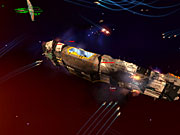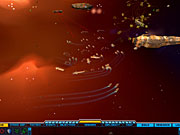Homeworld 2 Preview
We take a hands-on look at Relic's sequel to Homeworld, which puts you in command of bigger space fleets than ever.
No game has re-created battles between fleets of spaceships like Homeworld. Relic's 1999 debut game was the first 3D real-time strategy game that let you move the camera and ships in any dimension, not limiting the action to a 2D plane. When this was combined with dramatic visuals that put tiny fighters next to massive capital ships in combat, the result was a unique experience that represented epic space battles in a way previously only found in sci-fi books and movies. A full sequel to Homeworld is now just months away from release, and it's designed to be faithful to the original while evolving the game mechanics, extending the original game's satisfying story, and bumping up the level of visual detail. We recently had the opportunity to play through an early version of the game that gave us a peek at the single-player story and the multiplayer battles.

The original game told the story of the hiigarans' return to their homeworld, a return that involved building a huge mothership capable of traveling to hyperspace and defeating the taiidan. As it turns out, the hiigarans are one of the few galactic civilizations with hyperspace technology, and this let them become a dominant force following the fall of the taiidan. But now, of course, there's a new threat: the vaygr. The introductory sequence hints that prophesied events are at hand, but what you really need to know is that the vaygr are dangerous, and what's more, they have hyperspace technology. As Homeworld 2 begins, the vaygr launch a major attack on the hiigaran homeworld, but not before a new mothership can be completed.
The preview version let us take a look at the first two of the 15 levels to be featured in the final game, which producer Dan Irish said will offer about 40 hours of single-player gameplay. As you might expect, the first level starts out slowly, and it gives you a short series of simple resource harvesting and attack objectives to figure out the basic game mechanics. At the very beginning of the game, you'll see the hyperspace core being inserted into the mothership; a series of tests has been planned before the enormous vessel will launch from the secret base where it was built. But after only a few minutes of basic tasks, an outlying ship detects something that will cut the tests short: the first wave of a vaygr bomber attack.
For simplicity's sake, the new game organizes the smaller ships into squadrons, and you'll quickly have to build more than the one group of five interceptor fighters you have on hand at the start of the attack. Once you've constructed a few more, you'll be able to quickly get them all in a control group and group-select the enemy to dispatch them. But soon, three of the vaygr's special hyperspace gateway units cruise into view, threatening to bring in enemy reinforcements waiting some distance away if these gateway units are allowed to make the arrangements. However, by this time, you'll have a few bomber squadrons of your own, so you'll be able to take down the enemy reinforcements and let the mothership escape into hyperspace.

Another cinematic--animated in the same simple black-and-while style as in the original game--then appears to inform you of the vaygr's attack on the homeworld and their apparent pursuit of the mothership. But the mothership isn't quite ready yet: A ship as large as this requires a crew the size of a city, and the bare-bones crew that has been testing the ship needs to meet up with transports carrying the full complement. At the rally point, you'll encounter a wider range of enemy ships. To defeat the carrier and missile corvettes that attack the transports, you'll need to respond with corvettes of your own, though some friendly frigates arrive later to mop things up. While those familiar with Homeworld will have a good understanding of how the game's units are balanced, this early fight is a good introduction to how the four major ship classes--fighters, corvettes, frigates, and capital ships--can work together to counter different threats.
In Space, Which Way is Up?
Diving into the multiplayer battles provided an even better look at the hiigaran and vaygr units. Multiplayer games start you out with a mothership, a carrier, and a few resource collectors to send to nearby clumps of resources floating in space. It's fortunate that you have the carrier from the start, because you can immediately move it to another resource area and speed up your collection efforts, which are otherwise limited by how fast collectors dock with the mothership. The carrier is one of several capital ships that can now build ships on their own--it and the battlecruiser can build up to frigate-size vessels, and the huge shipyard can build all the way up to capital ships.

At the start of a match, it's always a good idea to build a research module and send out scouts, but in Homeworld 2, you'll actually be able to make these strategies work together. In the sequel, it will be possible to research technologies that let you build new types of ships as well as technologies that let you improve the ones you have. For example, the cheap scout can be upgraded with an attack that temporarily disables ships and an active sensor that "pings" enemies further away to better keep track of enemy movements on the game's sizable maps. You'll also be able to research specific armor, engine, and hull upgrades for many ships, but not the most powerful, specialized ones. Another upgrade option is limited to capital ships: All except the destroyer will have expansion slots for ship construction facilities and upgrades to add hyperspace abilities, better sensors, fire control towers for ship coordination, and others. But now that ships have subsystems that are visible on the hull exterior, it's possible to train your ships' weapons on those systems and destroy them. This key development opens up new tactical possibilities, like sending in bombers for surgical strikes against the construction modules on unescorted enemy ships.
The four ship classes fall into a clear-cut pecking order in terms of sheer power, and the much larger ships are generally much more powerful and expensive than fighter squadrons. For instance, the hiigaran's torpedo frigate is designed to take out corvettes, while the flak frigate will clear away clouds of fighters, and the ion frigate can take down large ships with its huge energy cannon that runs down the core of the vessel. In addition to these ships, which specifically counter enemy units, the hiigarans have some special units, like the defense field frigate, which protects nearby ships. The sequel actually has many more special units than the original game did, including probes that disrupt enemy sensors in an area, a vaygr command corvette that improves the accuracy of nearby ships, and defense platforms.
While the vastness of 3D space always makes it hard to lock down territory as your own, the two types of static defenses--one with guns for use against fighters and one with ion cannons--make it possible to deter smaller enemy raids. Relic has stated that the game's multiplayer maps will have a variety of terrain features that will make the maps seem less empty than the first game's and create strategic chokepoints, though we were only able to try out the two- and four-player versions of a single, wide-open map. In any case, having good static defenses, in addition to minelayer corvettes, can also let you concentrate your own forces in powerful fleets. From what we've seen, gathering a huge battle group won't merely be an issue of gathering enough resources; for instance, though we collected resources quickly, we often found that the game's unit limit would kick in just as we began building capital ships.

Homeworld 2 makes many gameplay changes that may seem quite subtle at first. No one would ever say that Homeworld's interface for moving ships in 3D was accessible, but with practice it did allow for intricate tactics that relied on long-range hyperspace jumps and use of 3D ship positioning and formations. The new game makes moving from point to point much easier and adds a strike group feature that makes different types of ships work together intelligently. These moves do away with some micromanagement and put more emphasis on broad build strategies in a way that's more similar to more conventional real-time strategy games. While most of the 32 developers now working on Homeworld 2 weren't involved with the original game, the art team is the same, and one result is that the visual style will seem very familiar to fans of the first game. The graphics have been updated with higher levels of detail and plenty of new effects, but most fans of the original game will probably notice more-significant changes to gameplay rather than to the graphics in the sequel. Homeworld 2 is currently in a late alpha stage of development and is scheduled to be released at the end of August.
Got a news tip or want to contact us directly? Email news@gamespot.com
Join the conversation